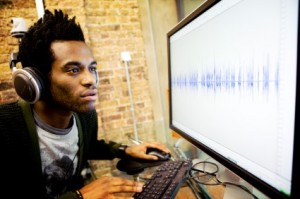 By the time you finish reading this article, you will have a functioning multi-track digital audio recording studio without having to spend any money.
By the time you finish reading this article, you will have a functioning multi-track digital audio recording studio without having to spend any money.Interested? Read on!
Have you ever wished you could record your a podcast, or a song, or create audio for the videos you took at a wedding or graduation? Maybe you want to start a voice-over business or even your own record company. Then you come back to reality and resign yourself to paying a “professional” to do all this stuff. Why is that?
I’m guessing you have been reading (and believing;)) some of the “how to set up your home studio” articles that talk about the “minimum” amount of gear and/or software you will need to buy BEFORE you even get started learning how to use it all.
Would it change your mind if you discovered that you didn’t need to buy ANY gear? Or that if you did, it was going to be about $5.00? What if in addition to that great news, you also discover that it can be fun and easy to learn home recording? Well guess what? It’s all true.
If you have a PC (or Mac) with a sound card, an mp3 player (for the headphones), and just about any kind of microphone, and an internet connection, you already have the gear you need for a home digital audio recording studio. The only other thing you need is software, which you can go get right now…literally. The software, called Audacity, is extraordinarily powerful, and best of all…it is free! I don’t mean free-for-30-days. And I don’t mean shareware. I’m talking “open-source” free…as in you pay no money for this software, ever.
Just go to the Audacity website at “audacity.sourceforge.net,” download and install Audacity, and you’ll have a home recording studio capable of multi-track recording (for adding music behind your voice, singing harmony with yourself, being a 1-person-band, etc.) and audio editing. All you need now is a bit of guidance to show you what to do. Luckily, there is a lot of free guidance available as well.
There are several tutorials on the interwebs these days to help you with Audacity, starting with the ones on the Audacity website. If you’re like me, you want short, to-the-point, fun, video tutorials that will teach you just what you need to know, when you want to know it. If so, come take a look around at Home Brew Audio, and start using that home digital recording studio you didn’t even know you had!
Now get busy!
You have written and made available, some very useful articles. Thank you. Us newbies need all the free help we can get.
There is one thing I’m confused about. You strongly recommend both Reaper and Audacity. Since they both appear to do the same thing, which is it?
I have both, and have been using Audacity for about a month, creating voice overs (30 years in the radio/TV industry). The program is very powerful. Which, as you know, is another way of saying, it can be a bear to learn how to use.
I havn’t started with Reaper yet. Should I even bother? I don’t need any more time wasting wheel spins. If Audacity will do everything I need, should I just stay with it? (OK, my curiosity will force me to boot Reaper, but probably just for a quick look. I need to stay focused).
Appreciate your opinions and advice.
Terry E
Terry,
Reaper’s primary function is as a multi-track digital audio workstation. This is perhaps more of an issue if you are recording music. The multi-track, midi, and other pro capabilities are light years ahead of Audacity. As a DAW, however, Reaper isn’t the program of choice for “editing and finalizing” a single audio file. You need an audio editor for that. Audacity is primarily that, an editor. But since it does some multi-track stuff too, if all you do is voiceovers with the occasional background music or sound effects, you may not need Reaper. But the more you work with multiple tracks (more than 2 tracks, say), the more the capability of Reaper surpasses that of Audacity. If you’re going to be producing music, Reaper is a must. Then you mix all the tracks down to one file, which you edit with an editor like Audacity or Adobe Audition.
Hope that helps!
Ken